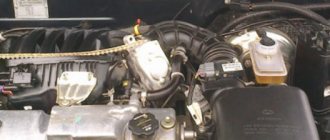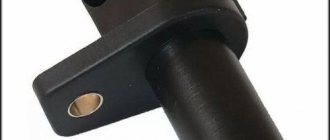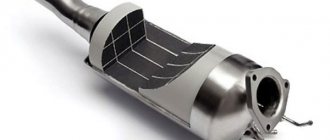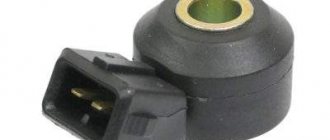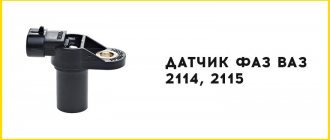Each car includes a large number of different sensors in its design. These devices are necessary to monitor the status of the main components of the car and transmit information to the electronic control unit. Based on the received data, the ECU adjusts the operation of a particular system and makes appropriate changes if necessary.
The knock sensor on the VAZ-2114 is located between the engine cylinders. This arrangement allows you to achieve the greatest efficiency from this simple but extremely important mechanism. What is the main purpose of the knock sensor and what are the main signs of its malfunction?
How does the sensor work and why is it needed?
The operation of the mechanism is based on the principle of a piezoelectric element. This means that if vibration of a different nature occurs in the engine cylinder, a signal will be transmitted to the ECU using electronic pulses. In turn, the final element in this chain will make changes to the operation of the ignition angle.
This algorithm of actions allows you to protect components and parts from mechanical damage. On the “fourteenth” in most cases there are broadband mechanisms, but often the manufacturer also installed a resonant type of device, most often on the very first copies of the VAZ-2114
The fundamental difference between a resonant type device is that it is capable of capturing only noise at the detonation frequency.
The broadband mechanism is superior to its counterpart in that it has a wider range of capabilities. Such a sensor is capable of capturing noise of various frequencies, which undoubtedly gives the vehicle system additional stability.
The devices operate on different principles, therefore, if the resonant sensor breaks down, it cannot be replaced with a broadband one. The situation is similar in the opposite case. If there is an urgent need to replace or change the operating principle of the mechanism, you will have to purchase a new control unit.
Detonation. Arbitrary self-ignition of fuel
Detonation is formed in the combustion chamber during the chemical reaction of combustion of the gasoline mixture. During the chain reaction, gaseous secondary products, mixing with the vapors of the initial mixture, re-enter the combustion process, creating an uncontrolled explosion and spontaneous combustion of the fuel mixture. In essence, this is an unintended and untimely combustion, accompanied by a blast wave and increased coking.
So, starting the next stroke, the piston in the internal combustion engine compresses the mixture, creating pressure in the cylinder. Then, after some time (fractions of a second), ignition should occur. However, due to the above reasons, abnormal ignition occurs already at the moment of compression (without withstanding that split second).
The flame spreads throughout the chamber and a front of increased pressure is formed. Coupled with the pressure of the piston on the mixture, the pressure from premature combustion creates conditions for the formation of volatile, flammable compounds (alcohols, formaldehydes, oxides), which trigger a chain reaction. The result of all this is a point self-ignition of an explosive nature.
Main symptoms of a malfunction
If the VAZ-2114 knock sensor begins to function incorrectly, then in most cases the driver will be able to notice a flashing Check Engine light on the dashboard. At the same time, it is easy to notice a malfunction by the very behavior of the car. The car accelerates poorly, does not overtake, and “chokes” when going uphill. The engine is unstable and shows obvious signs of failure. Other symptoms include:
- frequent overheating of the motor;
- when you press the gas pedal sharply, a detonation knock is clearly audible;
- The on-board computer generates an error, the interpretation of which indicates a sensor malfunction.
Detonation knocks often occur due to low-quality gasoline. If all of the above symptoms are present, it is best to conduct a full computer diagnostic of the car. Monitoring will allow you to determine at which stages of engine operation the worst performance is observed, and computer diagnostics will also allow you to find out the error code of the knock sensor.
Diagnostics can detect faults such as an open circuit, signal level exceeding or its value being too low.
If the diagnostics determines that the knock sensor is faulty, you still need to make sure that the device is not functioning correctly.
see also
Purpose and location of FLS
The FLS is located in the fuel module, which also includes a fuel pump and fuel filter.
FLS location
Its main purpose is to monitor the fuel level in the gas tank.
The design of the device includes:
- float;
- dielectric plate with a located rheostat;
- the rod on which the contact slider is located.
FLS appearance
Checking DD at home
How to check the knock sensor of a VAZ 2114 at home? It is possible to determine the performance of the mechanism using an ohmmeter or digital voltmeter. The first allows you to determine the resistance, and the second - the voltage between the contacts. A correctly functioning VAZ 2114 knock sensor has an almost infinite resistance. If this indicator is completely absent, then the mechanism must be replaced.
The procedure for measuring voltage with a voltmeter is as follows:
- Set the limit on the device to 200 millivolts.
- Connect the voltmeter probes to the DD contact.
- The sensor body must be tapped lightly, for example, with a screwdriver.
- Record the reading of the digital voltmeter.
Checking DD yourself
The knock sensor is located between cylinders 2 and 3 on the radiator side directly on the engine block. Checking the knock sensor is a simple matter, especially if you have ever looked under the hood of the fourteenth.
Replacing the knock sensor VAZ 2114
- The key end is 13 for a single-pin DD (resonant) and 22 for a two-pin DD (broadband)
- Simple screwdriver
- Multimeter
How to check the knock sensor
The first thing to do is remove the DD. It’s easier to remove the single-pin one: don’t touch the ignition, turn it off and unscrew the sensor from the engine. The two-pin one is more complicated: we also don’t touch the ignition, but we also need to remove the negative from the battery. Then, remove the wires of the block, unscrew the DD fastening and remove it.
Second, we switched the multimeter to a voltmeter and set the limit to 200 MV. We connected it to the DD and carefully hit it with some piece of iron (the same screwdriver). When impacted, the voltage should jump; if there is no jump, the sensor is dead, go to the store for shopping.
When a two-pin DD is connected, its terminals cling to the multimeter, when a single-contact DD is connected, one contact and its body are clinging.
Third, we look at the wiring, as already mentioned, most often it’s a matter of frost, or broken contacts.
A simple plan on how to check the knock sensor in your garage with properly trained hands.
Opinions agree that a non-working DD should not be replaced with an analogue from the factory. You will buy a pig in a poke with a 1 in 10 chance that you will get a working one. For the fourteenth, DD from 406 engines for the Volga or universal imported Bosch are perfect.
How to replace the sensor
Replacing the mechanism yourself is not difficult. It is located between the second and third cylinders; you need to open the hood and provide yourself with unhindered access. It is important that the engine is turned off at this time. As soon as the DD is detected, it is necessary to disconnect the plug going to the sensor wires.
If the mechanism is broadband, then to complete all the work you will need a key set to “13”. In the case of a resonant device, you should arm yourself with a key set to “22”. You just need to unscrew the nuts from the stud with a “13” wrench or the piezoelectric sensor itself with a “22” wrench. It is also necessary to clean the contacts with sandpaper to remove all dirt and oxidation. This procedure should not be neglected, because the quality of the transmitted signal depends on the state of the contacts.
Oxidation and various types of plaque interfere with the transmission of a high-quality signal. As a consequence, this leads to a decrease in the level and accuracy of the impulse, which will leave its mark on the operation of the car. After which it is necessary to install a new mechanism and reassemble in the reverse order.
Connection diagram
The sensor connection in 2115 is shown in the figure.
3 wires are connected to the installed device. Inside the device there is a sensing element and a signal converter, which includes an operational amplifier, a bridge circuit and an output stage.
The operating principle of the sensing element is based on the Hall effect. Once the received signal is converted, it is transmitted to the controller.
Replacing the VAZ knock sensor
The knock sensor on injection VAZ cars is located on the cylinder block in the front part. Before you begin to unscrew the mounting bolt, disconnect the chip from the sensor by pulling out the locking bracket. To unscrew the DD you will need a 13 key.
After removing the old sensor, do not rush to install a new one immediately. Before replacing, thoroughly wipe the sensor seat from oil, dirt and other debris to ensure a perfect fit of the sensor to the engine block.
The tightening torque DD should be within 10 - 24 N.m. If you don't have a torque wrench, you can lightly tighten it by hand, just don't go too hard.
Almost all modern gasoline engines have an electronic engine management system. The VAZ 2114 car is no exception - the distributed injection system is controlled by an electronic unit. The unit monitors the operation of various sensors and, based on their readings, regulates the fuel supply and commands the ignition system. Failure of any of them leads to malfunctions of the vehicle. The knock sensor on the VAZ 2114 is no exception; the stable operation of the engine also depends on it.
Location of the knock sensor on the VAZ 2114
Conclusion
A knock sensor is one of the simple but very effective solutions that is widely used in electronic systems for protecting engines from self-ignition of fuel. With such a sensor, the electronics themselves can solve the problem of detonation , thereby improving engine behavior and reducing wear on the pistons, cylinder head and cylinders themselves. We can also note a serious decrease in fuel consumption after replacing the old faulty sensor with a new one. So the DD cannot be called an ineffective device for a lot of money. On the contrary, with it you can safely realize the full potential of injection engines. Many engineers recognize the simplicity and elegance of this device, capable of working in almost any environment in close cooperation with the ECU. So if your car has a knock sensor and you are unhappy with its performance, it is worth repairing it yourself or buying a replacement, because it is worth every penny spent.
Today you can find many good analogues of German and Japanese production that will serve you faithfully for a long time. We would even venture to suggest that a one-time installation of a new high-quality sensor will be enough so that you no longer remember the problems associated with it for the entire further period of operation of the car.
DEVICE AND PURPOSE
The basis of the knock sensor (DS) is a piezoelectric element. When mechanically applied, an electrical impulse is generated on it, this impulse is sent to the engine control unit. The electronics detects the occurrence of detonation and, based on the data obtained, adjusts the ignition angle, thereby protecting the internal combustion engine (ICE) from mechanical damage.
To find out where the knock sensor is located on a VAZ 2114, you need to open the hood and look under the cylinder head between the second and third cylinders; it is installed on the internal combustion engine block (this can be seen in the figure above). On a 16-valve engine it will be more difficult to see right away; the cylinder head is more massive and blocks the view.
There are two types of DD:
- Resonant (single-contact),
- Broadband (two-contact) sensors.
What types of DD are there?
The resonant knock sensor was installed on early releases of VAZ 2113, VAZ 2114 and VAZ 2115 cars (they are completely interchangeable). It is rarely found on sale lately, and the price of the part is quite high. A single-contact knock sensor works on the principle of capturing the detonation frequency, while a broadband (two-contact) sensor receives the entire noise band, and then detects detonation noise in it. These devices are not interchangeable, as they operate on different principles. Replacing the wiring does not solve the problem, so when remaking the system, you also have to change the electronic control unit (ECU).
But replacing the ECU is ultimately worth it, given the difference in price of the parts. A resonant DD from GM costs approximately 2,600 rubles. At the same time, the price of broadband DD is in the range of 230-320 rubles. If desired, a spare part can be found even cheaper, for example, a two-pin DD manufactured by StartVolt is sold at a price of 170-210 rubles. It makes sense to redo the entire system once rather than constantly have to worry about finding and replacing a single-contact knock sensor.
OPERATING PRINCIPLE AND FUNCTIONAL PURPOSE
Let's figure out what a knock sensor is used for using its typical operating cycle as an example.
When the engine is operating in normal mode, the DD, roughly speaking, sleeps. However, when detonation begins to occur inside the cylinder block, the sensor reacts to its power and sends a corresponding signal to the ECU. Based on the information received, the controller changes the ignition angle until detonation in the fuel combustion chambers disappears.
What does the knock sensor of the VAZ 2114 affect? Without it, the electronics of the fourteenth cannot set the correct ignition timing, which threatens engine malfunctions: if the timing is smaller than necessary, as a result of micro-explosions, the engine will not be able to produce its usual power, and the valves in the cylinders will wear out quickly. More than necessary - gasoline consumption will increase, acceleration dynamics will decrease, and the engine itself will constantly overheat.
The operating principle of the knock sensor is based on piezoelectric effect technology. Inside the metal body of the device there is a plate that is highly sensitive to the force of mechanical influences exerted on it.
The device is the simplest
When detonation occurs in the engine, vibration is transmitted to the plate, which is converted by the sensor from mechanical energy to alternating current. The power of the generated current depends on the strength of the shock applied to the sensor.
There are two types of DD installed on the VAZ 2114 - broadband and resonant.
- The VAZ resonant knock sensor has a cylindrical shape. It is sensitive only to micro-explosions whose power is above a certain level;
- Broadband devices, on the contrary, are sensitive to all vibrations occurring in the engine, information about which they transmit to the ECU, and the electronics, based on the magnitude of the received alternating voltage, themselves determine whether detonation has occurred in the engine.
Resonant and broadband devices are not interchangeable, so if replacement is necessary, carefully select a new DD.
The cost of a new DD varies from 250 to 700 rubles for sensors of any type. We do not recommend taking domestically produced devices, since reviews from owners of fourteenth devices indicate that they have an extremely low working life. Moreover, under the guise of DD, ordinary dummies in an identical body, but without any functional filling, are often sold.
The best option is sensors produced by the German company Bosch; they cost almost 2 times more than the original VAZ ones, but at the same time they last much longer and work without problems. Also on the fourteenth you can install a VAZ 2115 knock sensor and devices for GAZ cars (article 18.3855), their mounting sockets are completely similar.
Knock sensor VAZ 2114 bosch
FAULTS
There are certain signs of a malfunction of the knock sensor on the VAZ 2114, which can be used to judge whether the part has failed:
- The Check Engine warning light in the vehicle interior lights up;
- The car accelerates poorly and there is a lack of power;
- When you sharply press the accelerator (gas) pedal, a detonation knock occurs (“fingers knock”);
- The engine overheats because, due to incorrect readings from the piezo sensor, the ECU sets the incorrect ignition timing.
The most common cause of detonation knocks is low-quality gasoline. Detonation also occurs when the engine overheats, and with a faulty motor, it can be clearly heard.
If there are signs of a faulty knock sensor and the engine warning light on the instrument panel comes on, computer diagnostics should be performed. For this purpose, the best option would be to use the Ascan diagnostic tester. On the scanner you can observe all the characteristics of the engine during its operation in all modes, and see what kind of knock sensor error is present.
Malfunctions of the knock sensor are also detected on the Ascan scanner; there are error codes:
- Error 0326 – exceeding the permissible DD signal level.
- Error 0327 – signal level is too low;
- Error 0325 – open circuit in the DD circuit.
A low knock sensor signal level is not only due to a faulty piezo sensor; there may be poor contact in the connecting plug or the sensor itself is poorly screwed to the cylinder block. Perhaps the contacts on the DD have oxidized; you can try cleaning them with sandpaper.
Open circuit of the knock sensor on a VAZ 2114 - three main reasons:
- The part itself is faulty;
- Power does not arrive or the control signal does not respond to the DD contacts;
- The DD housing has rusted at the mounting location in the cylinder block.
If there is rust on the DD body, the surface is also sanded, and if there is severe oxidation, the broadband sensor is easier to replace - it is cheap.
How dangerous is detonation combustion and what can cause it?
But if at least one of the conditions is not met, then there is a high probability of detonation combustion, which in the future can cause serious damage. The essence of this combustion is that part of the fuel, due to a number of prevailing factors in the combustion chamber, spontaneously ignites. Moreover, this happens before a spark forms between the spark plug electrodes, that is, the mixture ignites ahead of time.
The peculiarity of detonation combustion is that it is similar to an explosion. Combustion of the mixture occurs much faster and is accompanied by increased pressure and significantly higher temperature than during the normal combustion process of the air-fuel mixture.
The result of such combustion is melting of the piston bottom, burning out of it or the valves. In general, detonation in a power plant can cause enormous damage and require expensive and time-consuming repairs.
The cause of detonation may be:
- low-quality gasoline with a low octane number.
- design features of the power plant (compression ratio in the cylinder, shape of the combustion chamber, position of the spark plug, etc.);
- change in operating conditions in the cylinders (incorrect ignition timing, operation under load, the appearance of a significant layer of soot, deterioration in the quality of the air-fuel mixture).
CHECK AND REPLACE
Even if the scanner showed a malfunction of the DD, it’s a good idea to make sure that the part is not working.
The knock sensor is checked using an ohmmeter by measuring the resistance or a digital voltmeter by measuring the voltage between the contacts. The resistance of a working sensor on VAZ car models is almost infinite, but if it is small or absent altogether, the sensor must be replaced.
The voltage is measured as follows:
- Set the measurement limit on the voltmeter to 200 millivolts;
- The probes of the device are connected to the sensor contacts;
- Gently tap the DD body with any medium-heavy object (screwdriver, pliers);
- At this moment they look at the voltmeter readings.
At the moment of impact, the voltage on the device increases by 20-40 mV, depending on the force of the impact. The stronger the blow, the greater the tension.
REPLACEMENT
Replacing the knock sensor on a VAZ 2114 is very simple. If the DD is broadband, then you will need a combination key of 13; for a single-contact sensor you will need a key of 22. Do it as follows:
- We turn off the engine;
- Open the hood;
- We disconnect the connector plug on the wires going to the DD;
- We unscrew the 13 nut from the stud (in the 2-pin version) or the piezoelectric sensor itself with a 22 wrench (resonant DD);
- We put the new part in place and connect the plug.
That's it, very simple. You also need to take into account the tightening torque - the force is small, about 2 kgf/m². With greater force there is a risk of breaking the thread.
How to check the DD on a VAZ 2115?
Before you start checking the sensor, you need to carefully examine the condition of the part. If broken wires, dirt or other visible defects are detected, they must first be eliminated. Probably after this the previous problems will disappear.
If DD still needs diagnosis, this can be done in the following two ways. The first is without removing the sensor from the motor. A partner can help you complete the check. Here is the sequence of actions:
- Start the engine.
- The assistant’s task is to maintain engine speed within 1500-2000.
- Having reached the DD, you need to gently tap the device with a small metal object (for example, a screwdriver), gradually increasing the effort (to reasonable limits).
If the DD is working properly, the speed should increase. If no changes occur, then the part needs to be replaced. The second way is to check the sensor using a multimeter. Here's how it's done:
- The device is removed from the car.
- The multimeter must be switched to voltmeter mode and the switch set to 200 millivolts.
- The voltmeter probes are attached to the sensor contacts.
- You need to install a metal bolt inside the hole in the DD and tap it with a screwdriver.
During this process, the multimeter should display an increase in voltage. If the readings do not change, then the DD is faulty.
As you can see, you can detect a breakdown of the knock sensor yourself. However, if there are any doubts about the correctness of such a diagnosis, it is best to visit a car repair shop to determine the exact cause of the car breakdown.
Location, purpose and device
The DD in the Four is one of the main elements that determine the correct operation of the power unit. The main design element of the knock sensor is the piezo mechanism. When a load is applied to the knock sensor, the device generates an electrical pulse that is sent to the control module. The block detects the occurrence of detonation in engine operation, according to which it changes the ignition timing.
As for the location, in the VAZ 2114 the DD is located on the engine cylinder block, between cylinders numbered 2 and 3. If your car is equipped with an 8-valve engine, then you will immediately see the controller when you open the hood. As for 16-valve internal combustion engines, in this case it will be more difficult to find the sensor, since the view is blocked by the cylinder head.
Possible malfunctions and ways to eliminate them
What signs can be used to identify problems with the detonation controller:
- a significant drop in power, which is especially evident during acceleration;
- a Check icon appeared on the instrument panel;
- when you sharply press the gas pedal, detonation may be heard - a metallic knock, as experts say - “fingers” knocking;
- In some cases, the engine may overheat.
Controller failure is usually caused by regular use of low-quality fuel.
Instructions for diagnosing and replacing the controller
The diagnostic procedure can be carried out either using a tester or using an ohmmeter. When using a tester, the device itself will need to be connected to the connector for testing and diagnostics of performance. If you only have an ohmmeter, then you will need to measure the voltage between the controller contacts.
How to check the functionality of the DD:
- First, the measuring limit of 200 mV is set on the voltmeter.
- Then it is necessary to connect the probes of the diagnostic device to the contacts of the regulator.
- After this, try lightly tapping the controller body with a screwdriver or other similar tool. When you tap on the case, the voltage value on the tester display should increase to 20-40 mV, in this case it all depends on the force of the blow. If there are no changes as a result of the impact, then you need to change the DD to a new one (the author of the video is Alexander Dmitriev).
To perform the replacement you will need to do the following:
- Prepare standard plumbing tools - wrenches and screwdrivers; you will also need sandpaper or a steel brush. Turn off the power unit and turn off the ignition, and then open the hood.
- Then you will need to find the DD, press the latch and disconnect the wiring connector from the knock regulator.
- Using a wrench of the appropriate size, you need to unscrew the nut with the stud (if your car has a two-pin DD). If a resonant type controller is installed on the engine, then you need to remove the piezo element.
- After this, the contacts on the connectors will need to be cleaned with sandpaper or a wire brush - remove all dirt and oxidation. If this is not done, problems may arise in signal transmission - the pulse will not be accurate. When the cleaning is complete, install a new one instead of the old one.
Operating principle
The DD is based on piezoelectric effect technology. Its metal body contains a plate that is highly sensitive to mechanical stress. Detonation creates vibrations and acoustic waves that propagate in the cylinder block and are transmitted to the piezoceramic sensing element. It converts mechanical vibration energy into electrical voltage, transmitted as a signal to the control unit.
There are two types of DD on the VAZ 2115: resonant (1-pin) and broadband (2-pin). This all depends on the type of engine and year of manufacture of the car. It is difficult to say exactly which DD is installed on a particular car, so before purchasing it, it is recommended to look at the part, how it looks specifically on your car, and then make a purchase.
Resonant
Sensitive only to micro-fractures, the power of which exceeds a certain level.
Broadband
Such elements are sensitive to all vibrations generated in the internal combustion engine. The data is transmitted to the control unit, and based on the magnitude of the received signal, it itself determines the presence of detonation.
